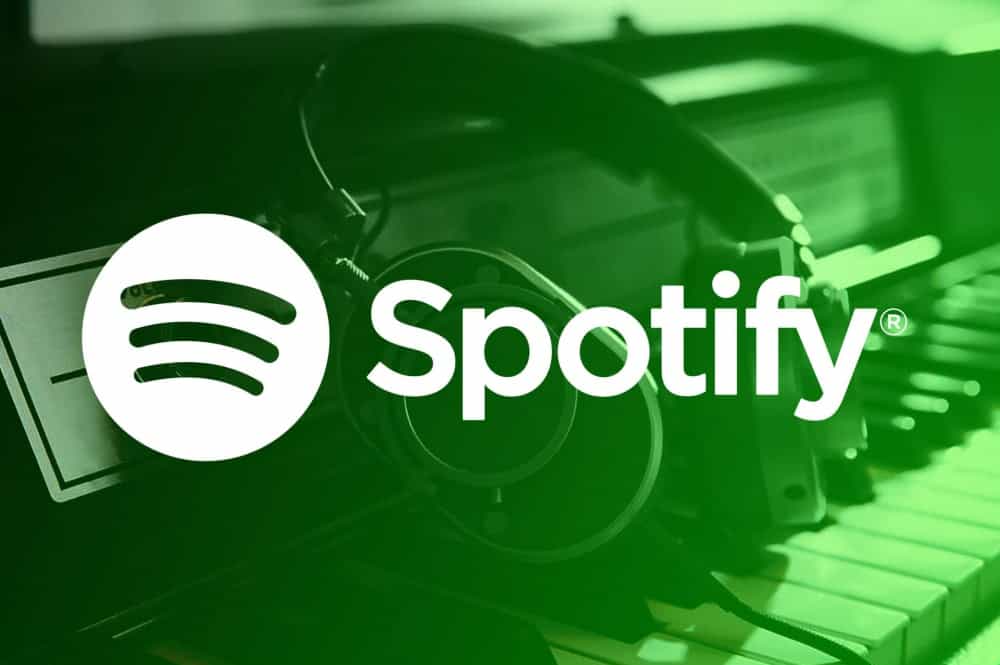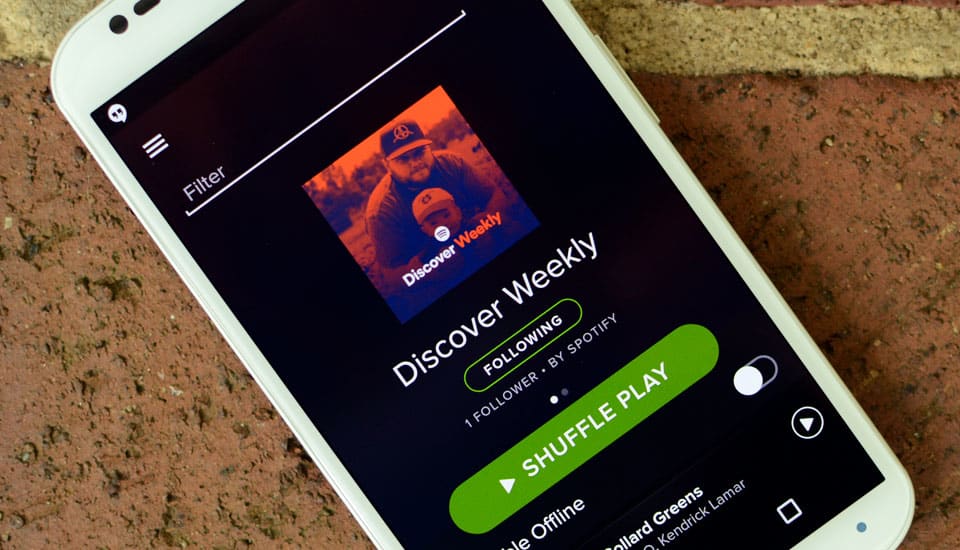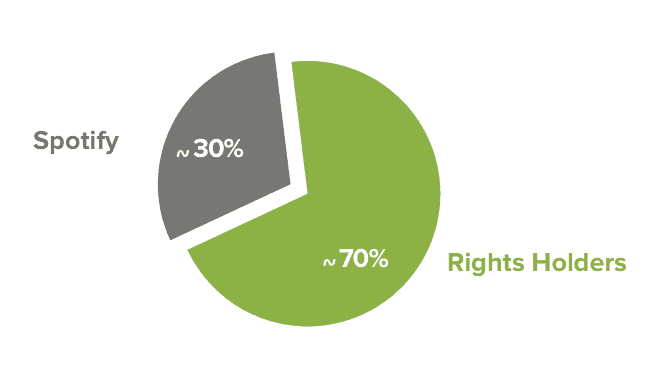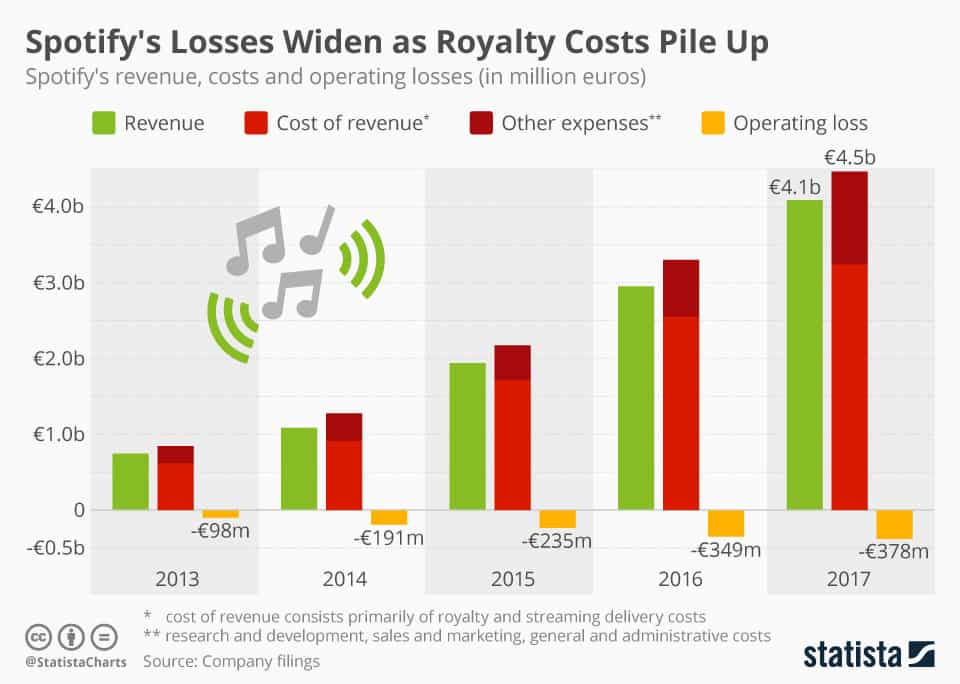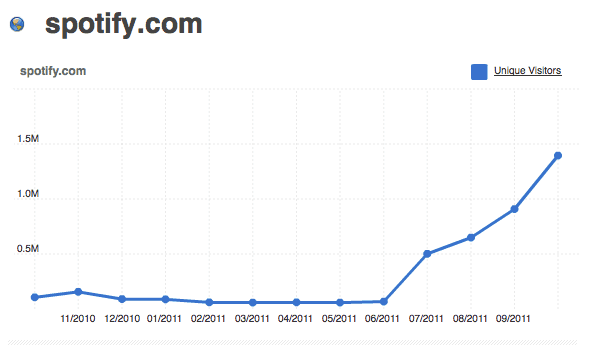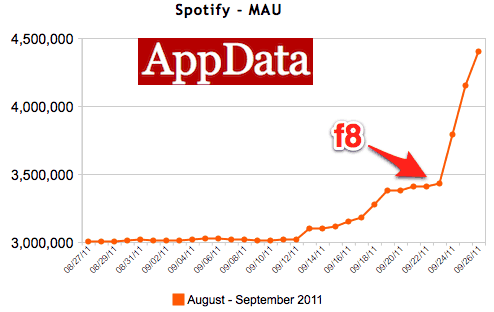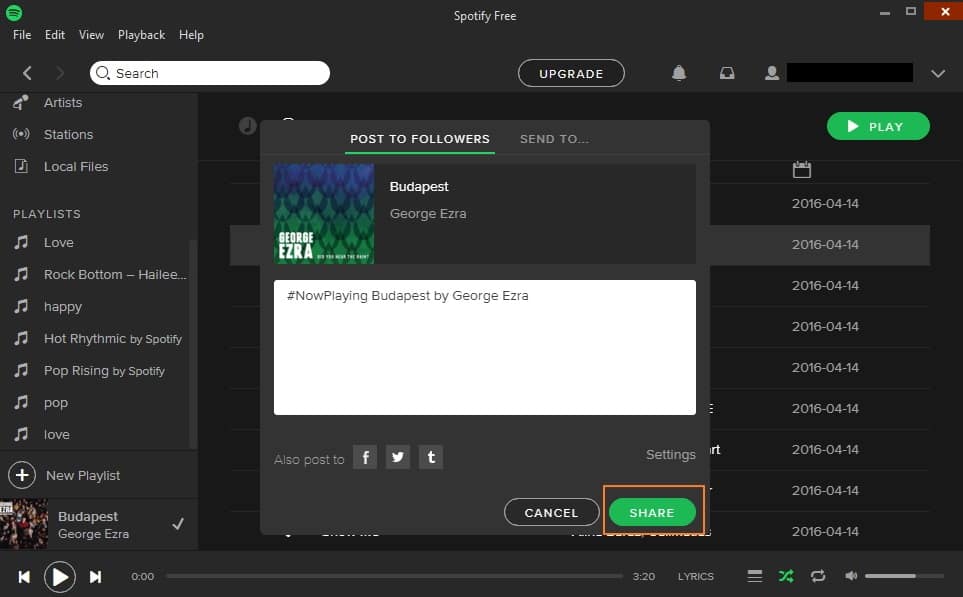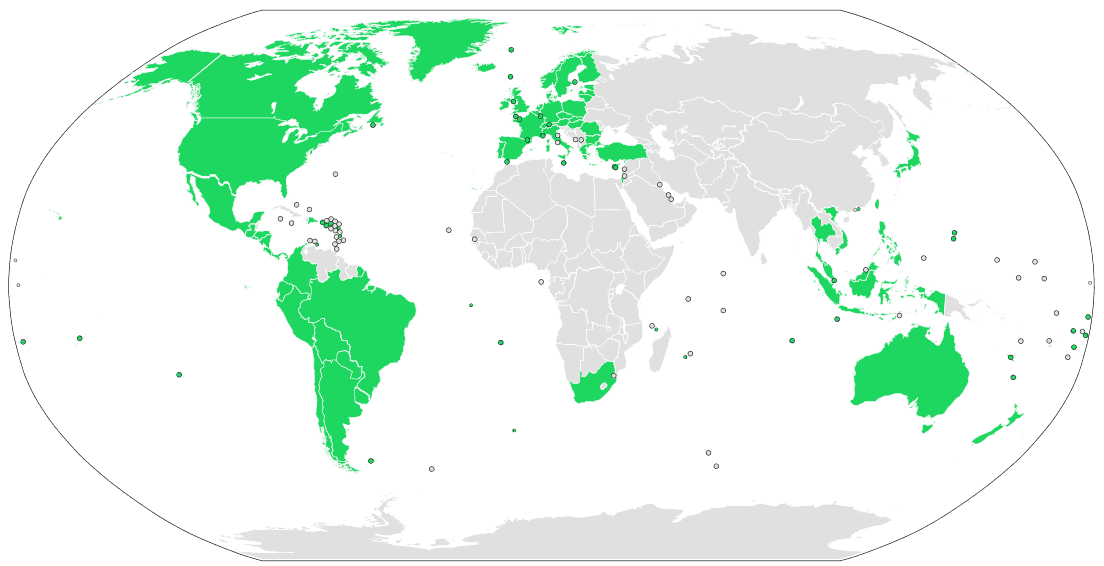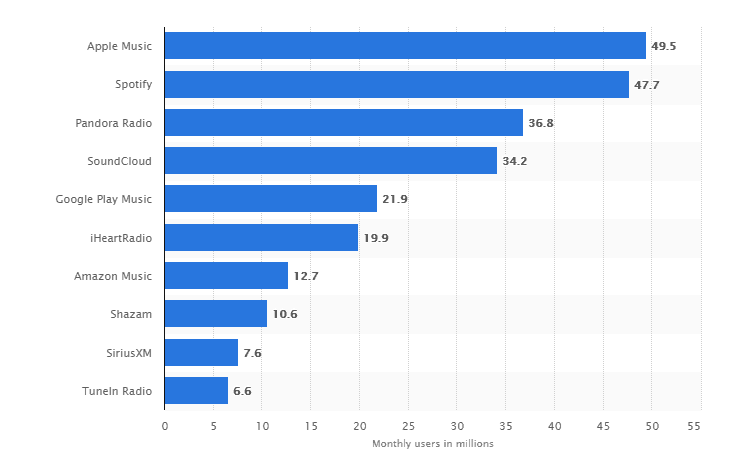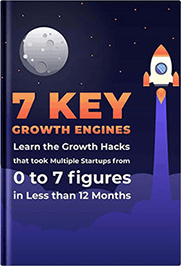The story of Spotify is a truly remarkable one. In less than a decade, the company has grown in value to $20+ billion boasting of more than 180 million monthly active users. Out of these approximately 80 million are paid, subscribers. So how did the company manage to achieve this feat and what is its growth engine?
This article dives into Spotify’s story to uncover the key elements that elevated the company to such heights. This article categorically looks at the:
Current Growth Levers of the Company
- The existing product strategy run by Spotify including, their, music catalogue, pricing model, product features and user functionality
- We will also have a sneak peek into their freemium business model that aims to bridge the gap between piracy and paid music and how this compares to the pay-per-track model of iTunes
- The massive US launch driven by their buzz after conquering Europe.
- Spotify’s controversy over royalty payments.
Future Growth Levers of the Company
- Possible expansion to countries that are still not supported and extensive mobile growth
- How Spotify can create new distribution channels by forging partnerships and alliances with existing as well as new platforms.
- Winning over producers as sole suppliers into the Spotify ecosystem
Introduction
The co-founders of Spotify, Martin Lorentzon and Daniel Ek met on a Quora thread in 2005 and shared many ideas back and forth before they finally landed on Spotify.
We discussed a lot of ideas back and forth and spent a lot of time hanging out in my apartment in a suburb to Stockholm. … We sat around my media HTPC machine quite a lot and thought that it was cumbersome to get content, despite the technology having been around (Napster) since at least 2000. I think that’s why we got stuck on the idea of Spotify.”
After the company’s official launch on October 7, 2008, it received series of funding. Series A brought in $21.3 million, Series B, $50 million and Series C $11.6 million. This inadvertently shot Spotify up in the world of streaming music. By September 2010, Spotify’s catalogue had closed the gap between itself and iTunes down to 1 million tracks.
With the growth in its music library, Spotify was also experiencing a surge in the number of users. Prior to joining the US market in March 2010, Spotify had an astounding 6.67 million users, with 1 million being paid subscribers. By end of 2010, paid subscribers doubled to 2.5 million and one year later the service had grown to 5 million paid subscribers out of 20 million users.
At around the same time the company received another two rounds of funding from a number of corporations bringing the total amount to $537.8 in funding. In 2018, Spotify has over 180 million subscribers 83 million of whom are paid, subscribers.
Image source: Statista
So let’s have step by step look at how this tiny office-apartment company with a broken coffee machine grew into becoming a giant that is disrupting the music industry today.
Initial Traction/ Early Growth
A DISRUPTIVE PRODUCT
Spotify launched in the United States with a very simple proposition, “Get almost any music you want anytime anywhere for only $10 per month.” Prior to Spotify, the few available platforms were Pandora and iTunes.
With Pandora, however, you could not pick your own songs and for iTunes, users had to purchase music on a singular track basis. Sure, other options existed like Rhapsody but they weren’t a fan favourite majorly because of single factors such as music catalogue, pricing model and the feature sets or a combination of these.
In contrast, Spotify sought to give consumers complete control over their music. All this at $10 a month, and in addition, the free plan offered legal radio streaming services. While many other companies offer these now, Spotify was amongst the first to offer this proposition and went a long way in cementing the company’s success as a disruptive force in the music industry.
There’s no doubt that Spotify and other online streaming services revolutionized the way people listened to music. Unlike Pandora and Last.fm, however, Spotify sought to accord the user complete discretion over the tracks and playlists.
With Pandora and Last.fm, the user only has the option to listen to whatever is available or skipping to the next song. Unlike Pandora and Last.fm, the interactive aspect of Spotify gives it an edge over its competitors and has been a major factor in driving growth to the service.
There’s more to the disruptive power of Spotify, however. For starters, aside from streaming music, users can also upload their own tracks to Spotify. This greatly reduces the resistance of new users joining the service as they could port their tracks to the service and enjoy them alongside Spotify’s.
In late 2011, Spotify shifted focus a little bit from on-demand streaming to the Pandora style radio. Spotify allowed users to expand a list of songs/artists/albums or genres into a station after analyzing user’s preferences over time.
This in conjunction with the Discover feature on Spotify meant that it could comfortable replace iTunes and Pandora.
Image source: Engadget
Late 2012 saw Spotify introduce a browser-based version of the service that was mostly geared for individuals who couldn’t download the desktop app. Users working on restricted computers maybe in the workplace, library, or using the Chromebook.
In 2013, a feature previously reserved for premium users, Spotify mobile streaming was made available to all users. In the same year, Spotify cranked up its output quality delivering up to 320 kbps making it one of the best if not the best in the market.
With all these feature sets available for consumers there’s no denying that Spotify is more than just a streaming service. Within the first five months of its inception in Sweden, the company had generated more sales than iTunes for Universal.
According to Sean Parker, a Napster co-founder and now an investor in Spotify, Spotify merges both accessibility and convenience by delivering all the music worldwide at only $10 a month.
Spotify has historically been compared to Pirate Bay and Napster but unlike these, Spotify grants users legal access to music by negotiating fair deals with record companies. When Spotify finally made it to the US, the chief content officer Ken Parks reiterated the words of Sean Parker referring to the service as a simpler and better alternative to piracy.
FREEMIUM BUSINESS MODEL
In any market, disrupting the pricing model normally allows the entrants to shrink the existing market made of legacy players who charge a premium for their services. iTunes, for instance, came in a sliced off a huge chunk of cash from existing services.
The interesting bit about a freemium business model, however, is not about the shrinking mechanism but the potential growth. This model acts as a medium between piracy and legal music sources.
Before Spotify, the only available options were to get music illegally, pay per track, or buy a CD. Spotify’s freemium model, however, satisfied the portion of the public that pirated music because of inaccessibility and or economic necessity.
The model also appeases new listeners and the service is betting on winning over those lost to piracy. By the look of things, consumers are buying into the idea. Spotify’s argument is that the users who aren’t subscribed to the premium plan are listening to ad-supported music which minimizes on the volume of content pirated.
Spotify has a unique value proposition that is changing the music landscape. Let’s see how the company engineered a freemium business model is a very strict right-based industry.
- Free: the free tier comes with shuffle play on playlists and restricted skips. In addition, this plan has 15-30 seconds of audio ads embedded and the music quality is at160kbps in Ogg format. The music quality in the free version is still better than Pandora, however, but with no download option.
- Premium: paid subscribers also have access to any song anytime but at a higher bit rate (320kbps). Additionally, subscribers get an offline mode and no ads. This plan costs $9.99 per month and students are accorded a $5 per month discount.
While streaming has always been unlimited in the US, this is not the same for all markets. Spotify placed streaming caps on free accounts for these regions but were quickly lifted after the first 6 months of operation.
The freemium plan comes at a big cost, however, because Spotify has to pay royalties for every song played. The company has, however; worked overtime in reducing these costs and also be able to pay artists fairly.
In order to understand how difficult it is to implement a freemium model in this industry understanding Spotify’s freemium models helps. Spotify retains about 30% of the proceeds while 70% is distributed amongst rights holders. The labels then divide royalties to every artist’s account.
Image source: Growthhackers
Spotify does not offer a fixed “per play rate” for songs played but users. Instead, the company’s payments are calculated based on a number of aspects including, the country where the country is being streamed, and the currency value of these countries. The paid versus the total number of users also play part.
On average these calculation brings down the payout to between $0.006 and $0.0084 across the available tiers. The chart below shows the company’s revenue, cost of revenue, expenses, and operating loss from 2013 through 2017.
Image source: Statista
Like Evernote and Dropbox, the freemium model has been a huge success for Spotify. The main income source for the company however still remains to be the monthly subscription fees by premium users and advertisement fees paid for adverts to free users.
It’s obvious that Spotify still prefers premium users to free users. In trying to reduce the number of free users, Spotify is thinking of introducing a free trial, a student rate and continue running ads on the free service.
EUROPEAN LAUNCH: BUILDING ANTICIPATION THROUGH INVITATION-ONLY FREE ACCOUNTS
Before Spotify’s advent in the United States in 2011, the company had sent ripples through Europe in France, Finland, Norway, Germany, Sweden Italy, Spain, and the UK. The company operated in closed beta for over 1 year with an invitation-only system that served to control costs and improve the early user experience.
This approach inadvertently increased hype around the service receiving heaps of praise from influencers and tech enthusiasts. Following the European public launch, these free accounts transitioned to paid accounts while invitations went wild over the next several months.
The scarcity of the service fueled anticipation and built anxiety amongst its target market. It wasn’t until February 2009 that Spotify opened to the public in the UK.
If the growth happened too quickly, the company was ready to inflict a temporary reinstatement of the invite system. This was the case in September days after the launch, where the company was forced to return to the invite system.
Spotify had to negotiate terms with record labels and the time this was done, the service had amassed 6.67 million users, 1 million of whom were paid subscribers.
FROM EUROPE TO THE UNITED STATES
Spotify’s anticipation had built up way before its launch and this only created a huge potential energy for growth of the services. Like in Europe Spotify used the momentum to their benefit. The company used tech bloggers and influencers such as Techcrunch, Lifehacker and Mashable.
At the end of it all, it wasn’t just tech enthusiasts and early adopters who took on Spotify early. Music lovers all over the globe invented ways to access Spotify from unsupported regions as well.
People invented backdoor ways to access the service. This showed that Spotify’s demand was not only in the US but the world over. Numerous forums and blog posts devoted posts entirely on bypassing Spotify without an invite in any country.
The unintentional wait for launch in the US was as a result of negotiations with record labels but also fueled anticipation even more. On July 14 2011, Spotify launched paid and invite on accounts in the US and users flocked to sign up and subscribe to the service.
Image source: MOZ
Initially, Spotify offered three-tier services namely; Free, Unlimited, and Premium. The Free tier was laced with adverts, was an invite-only system, featured unrestricted access on the desktop for the first six months, and afterwards limited to 20 hours monthly.
The other two paid plans were made immediately available for the US. The Unlimited tier featured everything included in the free plan but lacked ads and had no streaming limit. This plan cost only 4.99 per month.
The premium plan had all the goodies from the other two plans and also included mobile access via an app and offline access. The service received lots of plaudits the first few days of operation in the US noticeably from celebrities such as Trent Reznor, Ashton Kutcher and Britney Spears.
Music is about to be fun again! Join me at Spotify http://t.co/RiOQiBb — Talib Kweli Greene (@TalibKweli) July 14, 2011
Rainy day in NOLA but nice to be home. Just posted my fav playlists on Spotify. Even posted my boy’s favourite songs http://t.co/wpkxM5A -Brit — Britney Spears (@britneyspears) July 14, 2011
What a relief, now that it’s legal in the US, I can finally come out of the closet about my #Spotify addiction. — Ashton Kutcher (@aplusk) July 14, 2011
In order to extend their reach and distribute the free plan invitation, Spotify collaborated with a number of brands during the launch; Motorola, Sonos, Chevrolet and Coca-Cola. Advertised by the popular social media influence ranking service Klout, both Spotify and Klout almost crashed on launch day causing the service to be stopped temporarily.”
SOCIAL: DISCOVERY AND SHARING
Like its predecessors, Spotify has a positive attitude towards sharing and discovery. In September of 2011, at The Developers Conference f8, Spotify CEO Daniel Ek announced a partnership with other media companies that allowed these companies to publish, listening reading and other activities to users’ timelines.
As you’d expect this novel idea at the time cause a massive spike in Spotify’s monthly active users going up by almost 30% that very week.
Image source: Adweek
Today users are able to register using an email or Facebook connect. Once registered, users are able to view friends’ activity including; their public playlists and what they are listening to. For the CEO Daniel Ek, sharing is a core music experience and is what kept Napster atop in the early years.
We believe that music is the most social thing there is and that’s why we’ve built the best social features into Spotify for easy sharing and the ultimate in music discovery. Even if you aren’t a total music freak, chances are you have a friend who is and whose taste you admire. I’m looking forward to connecting with some of you in Spotify and discovering some cool new tracks.”
In early 2010, Airbnb Product Manager Gustaf Alstonomer also reiterated the fact that sharing is the ultimate discovery in music. Consequently, he continues to heap praise on the service saying that the best thing about Spotify is that it has a unique URL for each track.
[This] might sound like a minor detail, which it is not. If everything is (technically) available to everyone the way we listen to music changes. Spotify has created a new way people share and send tracks, albums and playlists to their friends and others.”
Right from the start, Spotify was committed to facilitate the intrinsic social nature of music. From the ground up, social features were built into the service and collaborating with Facebook only fortified these elements helping Spotify grow further.
In addition to Facebook, Spotify also has the option to publish tracks to last.fm and individual tracks to social media sites as well as enabling users to embed music into blogs and websites. As if that’s not enough, collaborative playlists allow friends to curate playlists for parties, road trips and social function of all mannerisms.
Spotify’s social sharing features. Image via Spotify.
Since their inception, Spotify has always been geared to improve their sharing experience. In 2013, the company introduced more features; message, follow and browse.
Messaging allows users to users to engage in conversations over the app. This service is available for desktop and mobile versions of the service. In early 2013, Spotify changed the term “subscribers” to “followers.”
Users could follow friends, artists, influencers, celebrities etc. following this change while the browse feature allowed users to search for playlists made by influencers, artists, and friends. The latter included ways to search for playlists based on genre and mood.
The product manager Miles Lennon explains that ‘browse’ is a powerful feature that provides music for every moment. In addition to browsing playlists, it documents the latest albums and single releases from your favourite and soon to be favourite artists.
Along with the company’s strategy the messaging, follow and browse feature are a representation of how Spotify is working towards making other music services obsolete, Lennon spells out.
It’s important to have it all under one roof. Our hypothesis is that the best discovery experience will combine social—recommendations from people you trust, influencers, and artists; intelligent recommendation algorithms based on your listening history and tastes; and human curation by experts and millions of community members. The way we move the needle is by satisfying more use cases.”
SPOTIFY AS MUSIC IDENTITY LAYER: ACQUISITIONS, APPS, AND APIS
In addition to the acquisition of Tunigo, Spotify acquired Echo Nest for around $100M. Echo Nest and Spotify have the same view of music and were working together even before Spotify went public. The two companies had a strong working relationship, Ek explains:
We have a long relationship with the guys at Echo Nest that stems back to 2007 before Spotify was even launched as a service publicly. We’ve been working together for a few years. We look at the world in the same way.”
Echo Nest, an industry-leading music personalization and discovering API combined with Spotify’s technology, and platform created an audience that would not have possibly happened otherwise.
Echo Nest technology was implemented into Spotify’s radio algorithm and music app. Echo Nest impact was immediately observed with the release of an expanded web API’s and the rerun of artists, albums, and tracks directly from Spotify’s catalogue.
Users could see improved access to user data such as playlists and music saved in the library with user authorization of course.
On the long term, Echo Nest could help Spotify free itself from its green walls and become a bloom of getting legal music online. For instance, Uber the taxi company integrated the Spotify API into its app offering free music services to its riders.
In May of 2014 Algoriddim’s iOS app, djay integrated Spotify into its ecosystem giving its users a sneak peek into the Spotify catalogue. Initially, users of the djay app were only constrained to their personal music collection but Spotify expanded this to 20 million tracks along with Match and Automix.
Match uses an algorithm to suggest the next song while Automix creates a mix out of one song complete with transitions and effects. Algoriddim’s CEO laments that he never saw this automation coming prior to Spotify and Echo Nest’s collaboration.
Despite all this success, however, there have been bumps along the road for Spotify. The aforementioned API, which was well received by the public, was being phased out. The company announced that they would no longer be taking Apps submissions and developers should shift focus to their web API.
MOBILE
Spotify launched their mobile app for both Android and iOS, in the fall on 2009, While the mobile app was reserved exclusively for premium users initially; the platform was made available for free users with limited streaming capabilities as from December 2013.
According to Spotify numbers, the number of users tripled between 2013 and 2014. Perhaps this was because the mobile access came with additional functionalities for users or maybe the company’s move gave free users a taste of mobile functionality that led to their conversion from free to paid users.
While free users finally got mobile access, there are some limitations as they cannot play any song like they would on a desktop but are able to shuffle through tracks for an artist or a specific playlist. Premium users, on the other hand, have the option to play any song at any time, save data by favouriting a playlist or downloading it entirely for offline use.
As smartphone and mobile apps continue to penetrate, the free plan continues to be a critical conversion point as users would yearn for the same control they have on the desktop version of the service.
CONTROVERSY SPURS AWARENESS AND GROWTH
One of the biggest arguments in favour of Spotify streaming service is that people who weren’t paying for music previously are finally seeing the need to. These were the claims of Sean Parker based on studies conducted in Denmark, Netherlands, the UK, Sweden, and Norway.
Nevertheless, many artists have complained that the revenue generated by Spotify and other similar services are not enough to live on. Though the revenues are legal, the royalties artists receive from these services are very insignificant claims, David of Talking Heads.
He further accentuates that if artists are to live off this income, then they’ll be out of work in less than one year. As country singer and songwriter Rosanne cash outlines, she was paid a mere 114 USD for 600,000 plays which is outrageous.
While everyone gets paid handsomely, the music creators do not get their fair share. This brings back the long debate on whether Spotify adds value or destroys music careers.
This and many other controversies have stirred up Spotify over their royalty payment. On the flipside, Spotify gets publicity every time any high-profile artist gets into public dust. This tussle, in turn, creates awareness for Spotify amongst artists and users alike.
Most recently Taylor Swift, a high profile United States artist pulled down her entire catalogue of music from the service a week before launching her Billboard-topping album 1989. While this was a huge loss for Spotify, the company did gain from exposure on blogs and TV programs.
Future Growth
CAN SPOTIFY MAKE ARTISTS HAPPY?
This question without a doubt is essential in determining the longevity of Spotify as a music streaming service. While Spotify is trying to bridge the gap between paid and piracy, will they turn out to be losers or winners going forward? Or will they be replaced by big players such as Google or Apple?
You might recall, Redbox a successful video rental kiosk is now facing extreme pressure to close down from cable providers and on-demand streaming services such as Netflix and Amazon prime video.
At the moment, Spotify’s problems are more anchored towards product-market fit than growth, Joseph Bentzel explains.
Spotify’s full ‘product’—at its core—is really a form of ‘two-sided marketplace’ in which its ‘producers’—i.e. artists and writers—benefit from providing their offering via a paid and/or ad-sponsored revenue model.”
Taylor Swift very much differed with the two-sided marketplace and she personally saw that it did not offer her side the value it deserved. Instead, she saw the channel as a conflicting channel that interfered with other sources of revenue for her music.
While Spotify has clearly found a solution for one side of the model, the 80 million plus users. There’s still some work to be done for the producers. If one side fails, like in the case of Taylor Swift then the whole system breaks down.
In a blog entitled, “$2 Billion and Counting,” after the Taylor swift conundrum, Ek laments of his frustration regarding the failure to satisfy artist despite having paid over $2 billion in royalties. He continues to say that the industry has been plagued ever since its inception and that is what Spotify is trying to change.
All in all, one cannot deny that fact that the producer side of the spectrum are not happy and Spotify are doing all they can to enact speedy payments, increase transparency and enable artists to connect with their fans.
At the end of it all, artists need to get fair compensation for the hard work and the record labels need to do better. When an artist chooses to bring down their catalogue, we (music lovers) will be ones to suffer, says Ek.
INTERNATIONAL EXPANSION
Today Spotify has expanded to 60 countries worldwide and still has ambitions to spread further. This is in line with their goal to add more users and therefore be able to pay more in royalties.
Image source: Reddit
PLATFORMS AND PARTNERSHIPS
The best way Spotify can increase its user base is through partnerships and platforms. Along these lines, the company release SDKs for Android and iOS development and launched high profile integrations with large corporations.
Following their integration with Uber, Spotify rolled out services in Mexico City, New York, San Francisco, London, Stockholm and other major cities. This allowed the users to remotely control their Uber music.
To integrate the two, users have to connect to Spotify via the Uber profile control panel. Whenever the user requests an Uber, they are matched with the Spotify enabled Uber. The user can then control music from Spotify’s catalogue via the phone app and listen to music while waiting for the car to arrive and continue listening while heading to their destination.
Only premium subscribers could benefit from the Spotify Uber partnership but Spotify does offer a week trial so that Uber customers can try out the service before they delve in. By making such integrations only available to premium users, Spotify’s model not only increases its user base but also converts them into paid subscribers.
IS SPOTIFY SUSTAINABLE?
There are questions regarding the longevity of Spotify going forward. On May 2014 Joshua Brustein of Businessweek published a post citing evidence by Generator Research pointing to a number of factors why Spotify’s model could be “inherently unprofitable.”
The main author of the Generator Research, which was published in November 2013, claims that no music streaming service including Pandora, Rhapsody can ever be profitable no matter how well business was conducted.
According to the report, Spotify had lost $200 million since its inception but the company was coy when queried about the subject. Despite these staggering stats, music-streaming services are still having a go at it. By August 2014, Time.com conducted a survey and counted 102 available streaming services. This number, however, counts both basic and premium plans separately.
Nevertheless, that’s still a ton of competition for Spotify. The chart below shows the popularity of the largest streaming services in the audio streaming space as of March 2018.
Image source: Statista
Spotify has to fend off Pandora and Rdio but is now faced with giants such as Apple and Google. Looking at the monthly visitors from the March 2018, Spotify has done well to creep up on Apple’s iTunes doing well over 45 million users monthly.
Ek is particularly hostile to the giants Apple and Google by insisting that Spotify is all about maximizing the value of artists’ music. Unlike their counterparts, the service has no motive to drive sales of any accompanying hardware or software.
There’s no doubt that the market is increasingly becoming crowded with Beats and iTunes forming alliances and new entrants such as YouTube music streaming services coming on board. YouTube music service, in particular, is a huge threat owing to the fact that the site gets over 1 billion views per month and streams over 4 billion streams on Vevo alone.
GOING PUBLIC
In March 2014, TechCrunch reported that Spotify might go public anytime in the fall of the year. That time came and went by and then the company listed a job opening for an External Reporting Specialist. This well meant that the company was planning to go public soon as the reports are a requirement to comply with SEC standards.
Again, this quickly subsided and not a lot was heard until August 2014 when the company listed the same position again. Rumours went around that the company would go public in 2015. Still, 2015 came and passed until early 2018 when Spotify officially went public.
Spotify however, did not go through a normal IPO but rather a direct listing. On April 3rd 2018, Spotify hit the public market with an opening price of $165.90 per share.
Overall, there’s no denying that Spotify has come a long way in turning the music industry on its head, decreasing digital piracy and convincing millions of listeners to pay for music. Whether their strategy will be a sustainable one in the long term remain to be seen, but so far, the loss of $200 million is not very sustainable.



